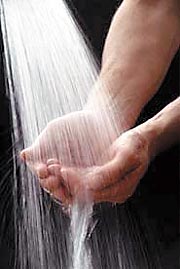
Water treatment will effectively clean up common contaminants that may be in water. Private well systems often need something to treat the raw water entering a home or business straight from the ground. But even treated water, sometimes referred to as “finished” water, coming from a public water filtration system could still use a little extra cleaning before it finally leaves the tap.
No one water treatment is perfect, and each one has its upside and downside. Following is some basic information regarding basic equipment types.
Water softeners are any group of substances that, when added to water containing calcium and magnesium ions, cause the ions to “precipitate” or change their usual properties. Water softeners typically are the first line of defense in residential treatment.
Distillation is another purification process that separates organic and inorganic solids from water by evaporation (vaporization) followed by cooling and condensation. Purifying water using a distillation system is almost a direct replica of nature's cycle.
A distiller boils water and it evaporates, similar to its evaporation from the surfaces of lakes, seas and oceans. It subsequently forms rain, or vapor. According to the WQA, when the water turns to vapor, everything except for the actual H20 is left behind. The distillation process removes contaminants such as algae, viruses, cysts, bacteria, arsenic, benzene, chloride, chlorine, copper, fluoride, lead, mercury, nitrates, odors, pesticides, rust, salt and sulfates, providing consistently pure water.
After the water is turned to vapor and is rid of all contaminants, the distiller boiler then collects the steam and again condenses it into liquid form leaving pure water to drink. According to the WQA, distillation is the most effective for removing the largest number of chemical constituents.
The distillation pro-cess is very slow and is limited in its capabilities, but it is one of the most effective ways to get the cleanest water possible.
Ultraviolet radiation is light that has a wavelength shorter than 3,900 angstroms - the wavelengths of visible light - and longer than 100 angstroms - the wavelengths of x-rays.
A particularly popular aspect of UV radiation is that it does not add chemicals to the water during its process. As water is passed through a transparent tube, an ultraviolet lamp shines on the water. UV treatment is effective in ridding the water of bacteria and viruses as long as UV light contacts 100 percent of the water.
Since some pathogens are less sensitive to UV light than others, making sure sufficient amounts of UV radiation are used is difficult. It is important to remove all sediment before the water enters the UV light. Another downside is that UV treatment has no effect on chemicals, lead or asbestos.
The ancient Egyptians discovered that storing water in charcoal kept it fresher and better tasting.
Carbon filtration is one of the common treatment methods employed today; it removes dissolved and particle matter, odor and taste from water. Water is either passed through a solid block carbon filter or flowed through a granular activated carbon (GAC) filter. Carbon filters also remove some pesticides and inorganic chemicals, but they don't remove heavy metals such as lead, copper or mercury.
There are two methods typically used in carbon filtration - physical straining, where the filter strains out particles and adsorption, with the latter being the primary method.
Adsorption is defined by Merriam-Webster's Collegiate Dictionary as “the adhesion in an extremely thin layer of molecules to the surfaces of solid bodies or liquids with which they are in contact.” This means that carbon can act like a magnet to certain chemicals at their molecular level, and GAC filters have been shown to remove elements such as radon from the water.
Filters are measured in pore sizes, or “microns.” For example, a 5-micron filter has a smaller pore-size than a 10-micron filter and will remove more chemicals out of the water. But the smaller the micron, the quicker the filter clogs up and needs to be replaced.
Filters must be changed regularly. Since the GAC acts much like a sponge, absorbing particle matter, eventually it fills up and becomes exhausted. At that point, the GAC needs to be replaced.
To avoid major health risks, these devices should be monitored and used to treat water that is already microbiologically safe or of known quality.
Another common system, reverse osmosis (RO), removes most water contaminants by forcing untreated water through a semi-permeable membrane. In RO, pressure forces the water to flow in reverse of the flow direction of natural osmosis, thus transforming a concentrated solution to a dilute solution.
To remove the broadest spectrum of water contaminants, RO usually is used in conjunction with an activated carbon filter. Reverse osmosis systems generally consist of three or more filters housing a special faucet fitted with an internal drain line air gap and a product or filtered water storage tank that can fit directly under the sink. ND
Report Abusive Comment